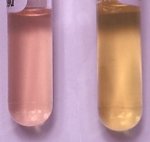The degree to which endogenous substances interfere with chemistry analyzers depends on the type of analyzer, the methods used to detect the analytes and the amount of interfering substances in the sample (i.e. laboratory-specific). The Hitachi chemistry analyzer used in the Clinical Pathology Laboratory at Cornell University measures the amount of lipemia, hemolysis and icterus in a sample and provides these values as indices. These indices can be used to gauge the effect of these three endogenous interfering substances on the chemistry results.
- Lipemia:
 Lipemia (lactescence) is caused by increased triglycerides (as chylomicrons or very low density lipoproteins). Lipemia interferes with chemistry tests by the following mechanisms: Lipemia (lactescence) is caused by increased triglycerides (as chylomicrons or very low density lipoproteins). Lipemia interferes with chemistry tests by the following mechanisms:
1) Light scattering: Results in falsely increased absorbance readings of some analytes, e.g. total bilirubin.
2) Volume displacement: This falsely decreases values of some analytes, e.g. electrolytes.
3) Hemolysis: Hemolysis of erythrocytes is enhanced in the presence of lipemia.
- Hemolysis:
 Hemolysis is usually an in vitro artefact due to poor venipuncture technique, lipemia, freezing of whole blood samples, delayed separation of serum or plasma from cells, or delayed sample submission. However, hemolysis can occur in vivo with certain types of hemolytic anemias (can you think of some examples?). Hemolysis is usually an in vitro artefact due to poor venipuncture technique, lipemia, freezing of whole blood samples, delayed separation of serum or plasma from cells, or delayed sample submission. However, hemolysis can occur in vivo with certain types of hemolytic anemias (can you think of some examples?).
Remember that hemoglobin-based oxygen carriers (such as Oxyglobin) are red and, consequently, interfere significantly with chemistry analyzers.
(For more information on HBOCs, refer to controllable biological variables.)
Hemolysis interferes with chemistry tests by the following mechanisms:
1) Increased absorbance: Released hemoglobin increases absorbance in the hemoglobin spectral range.
2) Inhibition of reactions: Released hemoglobin can directly inhibit chemical reactions.
3) Analyte release: Release of analytes found in high concentrations in red blood cells will falsely elevating the values of these analytes (can you think of some examples?).
4) Enzyme release: Release of enzymes which participate in chemical reactions, e.g. adenylate kinase (the value of which enzyme is artificially increased in this situation?).
5) Water release: Release of red blood cell water dilutes analytes.

- Icterus: Biliburin interference arises from its spectral properties and its ability to react chemically with other reagents (resulting in decreased analyte values - can you think of some important examples?).
- Hyperproteinemia: Monoclonal immunoglobulins (paraproteins), particularly when present in high concentration, interfere with chemistry analysis by the following mechanisms:
1) Hyperviscosity: This affects sample volume and is dependent on the class of immunoglobulin (which immunoglobulins produce hyperviscosity and why?).
2) Binding to analytes: Immunoglobulin binding to some analytes producing increased or decreased analyte values, e.g. hyperphosphatemia has been reported in a dog with chronic lymphocytic leukemia and an IgM monoclonal gammopathy.
3) Volume displacement: High protein concentrations (usually > 10 g/dL) produces similar volume displacing effects on electrolyte concentrations as lipemia.
What diseases produce a monoclonal gammopathy?
- Drugs: There are a number of different methodology-related drug interferences that may bias results. One of the most common drug interferences seen in veterinary medicine is the artefactual elevation of chloride values in samples from dogs on bromide therapy (an anticonvulsant). It is always wise to inform the laboratory of any medications in a particular animal, so that drug influences on chemistry tests can be minimized (but usually not eliminated).
|
 Lipemia (lactescence) is caused by increased triglycerides (as chylomicrons or very low density lipoproteins). Lipemia interferes with chemistry tests by the following mechanisms:
Lipemia (lactescence) is caused by increased triglycerides (as chylomicrons or very low density lipoproteins). Lipemia interferes with chemistry tests by the following mechanisms: Hemolysis is usually an in vitro artefact due to poor venipuncture technique, lipemia, freezing of whole blood samples, delayed separation of serum or plasma from cells, or delayed sample submission. However, hemolysis can occur in vivo with certain types of hemolytic anemias (can you think of some examples?).
Hemolysis is usually an in vitro artefact due to poor venipuncture technique, lipemia, freezing of whole blood samples, delayed separation of serum or plasma from cells, or delayed sample submission. However, hemolysis can occur in vivo with certain types of hemolytic anemias (can you think of some examples?). 